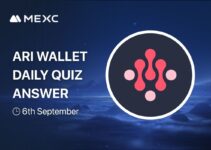
As of now, the TOTAL3 index – which tracks the combined market capitalization of all altcoins excluding Bitcoin and Ethereum – has officially reached a new high at $1.17 trillion. Price charts are glowing green, social media is flooded with FOMO, and it seems like “Altseason” is back.
Yet, when you dig into individual tokens, the picture changes dramatically. Only a handful of tokens are hitting new highs, while most are still probing the lows, liquidity is thin, and price charts are fractured by sell-offs.
This paradox isn’t caused by a single factor. It’s the result of multiple overlapping forces: the methodology behind TOTAL3, the wave of new token listings, massive unlock schedules, and a 2025 cycle that’s both unusual and misaligned with altcoins.

1.The Wave of New Token Listings: Inflated Nominal Market Cap
By early October 2025, major exchanges have listed up to 15 new tokens – the highest number since Q2 2021. Only $USDe from Ethena is a stablecoin; the remaining 14 projects are mostly tech, infrastructure, or DeFi tokens, many of which already completed multiple funding rounds at high valuations.
Every new token added to exchanges contributes to TOTAL3’s denominator, regardless of actual liquidity or circulating supply. The result: TOTAL3 rises due to “more names,” not because token prices are increasing.
For example, $XPL (Plasma) and $2Z (Double Zero) launched with billion-dollar valuations, yet average daily trading volumes hovered around just tens of millions USD. Similarly, $WLFI from World Liberty Financial once listed with an FDV of $6.8 billion, nearly on par with long-standing layer-1s.

Concentrated liquidity – only a few trading pairs on 1–2 exchanges – allows a handful of large orders to move prices dramatically. When reference prices rise, market cap jumps; but if someone actually tries to sell, the order books are too thin to absorb it.
In short, TOTAL3 reflects “nominal market cap,” not “liquid market cap,” creating an illusion of growth for a market that hasn’t genuinely expanded.
2.Unlock Pressure and Billion-Dollar Valuations from Last Year
Similar to above, TOTAL3’s nominal growth is also a “structural debt” left over from the 2024 token listing wave. Between late 2023 and early 2024, narratives like AI, modular networks, and zk-Rollups drove multiple major projects to launch tokens: Starknet, zkSync, Wormhole, Celestia… Most were valued in the billions from day one, accompanied by massive ongoing unlock schedules.
Starknet ($STRK) is a clear example. At listing, STRK had an FDV of around $26 billion – about $2.6 per token. However, starting April 2024, monthly unlocks began, with roughly 60 million STRK (~$120 million at listing price) entering the market each time. By the end of 2024, circulating market cap was only about $1.75 billion, with the price down nearly 4x from its peak.

Ironically, the nominal market cap barely changed, because circulating supply increased while price fell. TOTAL3 absorbed this “inflated” portion without reflecting the actual weakening.
This is the trap of high FDV and long-term unlocks:
- From an index perspective, the market looks larger.
- From a cash flow perspective, each unlock cycle adds real selling pressure.
Every unlock becomes a systematic selling cycle, creating a “wait-and-sell” mindset. Investors hesitate to buy early, while holders actively reduce risk. Meanwhile, teams and funds – holding the majority of locked tokens – must balance long-term commitments with profit-taking, creating persistent supply pressure.
In this way, FDV becomes an “overblown expectation,” while circulating market cap truly reflects health. TOTAL3 captures the increase in supply, but fundamentally it’s just noting dilution, not genuine growth.
3.2025 Cycle: Contradictory Signals, ETFs, and Deep Divergence
This cycle is one of the strangest in crypto history: Bitcoin peaked before its Halving, while altcoins are still probing lows, even though the Altcoin Season Index crossed 80 four times in September 2025 – a threshold usually signaling rotation into altcoins.
When breaking down individual tokens, contradictions emerge. Some large-cap altcoins like $STRK (Starknet) and $XPL, which were highly anticipated, have yet to reach corresponding highs. Meanwhile, tokens like $SUI and $ENA (Ethena) stand out due to buyback mechanisms and intrinsic cash flow.
This divergence stems from four main factors:
- Project Quality Differentiation: 2025 venture capital favors “core infrastructure” altcoins or those with clear intrinsic cash flow. New projects without proven value are left behind, creating a stark gap between “top picks” and the rest of the market.
- Fragmented Liquidity: Tokens spread across multiple DEXs and small CEXs have thin order books, causing volatile prices but poor sustainable growth. Retail investors often get caught in short-term swings rather than following long-term capital flows.
- Opportunity Cost: When $BTC and $ETH surge, altcoins must deliver significantly higher expected returns to attract capital. Most altcoins haven’t met those expectations, concentrating funds in top tokens while others continue probing lows.
- ETF and Spot/Altcoin ETF Impact: 2024 saw BTC ETFs, followed by ETH ETFs in 2025, channeling traditional financial inflows mainly into these two coins. Most altcoins missed out. ETF inflows into “ETF-standard” tokens exacerbate divergence, leaving the broader altcoin market in red, particularly tokens lacking product, liquidity, or intrinsic cash flow.
Derivative data further amplifies short-term volatility. High positive funding rates and growing open interest can’t replace actual spot inflow. Every leverage shakeout erodes trust.
The result is a “fake Altseason”: the aggregate index looks great, ETFs attract concentrated capital, but most investors still see red in their portfolios.
4.Lack of Narrative, Adoption, and Utility: Market Cap Up, Price Stagnant
TOTAL3’s rise is largely driven by newly listed high-valuation tokens, yet most altcoins lack adoption, real users, or intrinsic cash flow. The paradox: the index shines, but your holdings remain in the red.
- Weak or speculative narrative: Many tokens, especially meme or trend-driven coins, rely solely on hype and social media buzz without real products or value. Capital flows in for short-term speculation, and when hype fades, prices collapse.
- Low adoption: Even if listed on major exchanges, trading volumes and real users are thin, making prices sensitive to a few large orders.
- Weak intrinsic cash flow: Without mechanisms like fees, staking, burns, or revenue-sharing, prices depend on secondary investors.
Psychological effects worsen the issue: investors see TOTAL3 as an altseason signal and buy tokens lacking utility → facing sell pressure from unlocks or market makers.
5.Conclusion
The current landscape shows a clear mismatch between aggregate market indices and the micro health of individual tokens. TOTAL3 rises thanks to many newly listed high-valuation tokens, while most altcoins decline due to steady unlock schedules, concentrated distribution, thin liquidity, unproven value models, delayed product roadmaps, or simply overhyped expectations from 2023–2024.
Most projects cannot outpace their own unlock schedule. New capital demands standout products, adoption, or real user metrics, while tokens with only whitepapers and long roadmaps struggle. Each unlock is a stress test, while TOTAL3 is merely a flattering backdrop, lulling investors with nominal figures.
A strong index doesn’t guarantee a green portfolio. Even if TOTAL3 hits record highs, your altcoin holdings hitting lows makes the index irrelevant. Analysis should shift from “is the market going up?” to “does this token have a reason to rise?”
Investors should:
- Examine unlock schedules by month, cliffs, and potential sell pressure.
- Assess token distribution among teams, funds, treasury, community, and incentives.
- Check value-accumulation mechanisms: burn, utility, adoption.
Finally, look squarely at expectations: if a token lists at an excessively high valuation, the safety margin for secondary investors is thin. In a cautious market, a project must stand out in product, metrics, and clear value accumulation paths to grow.
Disclaimer: This content does not constitute investment, tax, legal, financial, or accounting advice. MEXC provides this information for educational purposes only. Always DYOR, understand the risks, and invest responsibly
Join MEXC and Get up to $10,000 Bonus!



